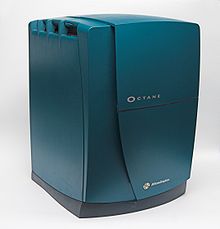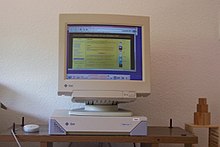Workstation
![]()
The title of this article is ambiguous. For the electronic musical instrument, see Music Workstation.
Workstation (German: "Arbeitsstation") refers to a particularly powerful workstation computer for technical and scientific purposes or for processing audio and video data, as distinct from the standard personal computer for private or office use. Typically, workstations are used in corporate and research settings for computationally intensive applications such as 3D design, computer simulations, video editing, and animated 3D computer graphics. Typically, workstations perform above average in graphics display, processing power, memory, and multitasking, and additional terminals can often be used. To increase reliability and longevity, technologies and components from the server sector are also used in some cases.
In the 1980s and 1990s, the market was dominated by workstations with Unix and VMS operating systems, and many manufacturers produced their own hardware based on vendor-specific high-performance RISC microprocessors such as the PA-RISC, MIPS or SPARC series. The acquisition costs were usually a multiple of those of average PCs. In the meantime, the combination of the most powerful Intel or AMD processors (e.g. Xeon or Opteron) with Microsoft Windows or Linux operating systems has also become widely accepted in the workstation segment, and most manufacturers no longer offer their own processor lines for workstations or have discontinued them altogether. The market is now dominated by large PC manufacturers such as Hewlett-Packard, Dell and Fujitsu, and most former RISC/Unix workstation manufacturers have shifted their business to other products.
Due to the increasing use of computers in product development, workstations are now of central importance in the creation process of industrially manufactured products. The range of applications includes design using CAD software, function simulation, the creation of digital prototypes of complex products and the design of tools and molds for manufacturing. A steadily growing field of application is also the creation of computer animations for feature films and television productions. In some cases, this involves the use of many individual workstations distributed across locations in several countries, which are interconnected to form a computing cluster in order to increase rendering computing power.

The SGI Octane was specially optimized for 3D computer graphics and was often used in video and film production for the calculation of CGI sequences. The Unix derivative IRIX was used as the operating system. At the beginning of 1998, the price for the entry-level model with 225 MHz MIPS processor, 128 MByte RAM, 4 GByte hard disk and 20-inch monitor was about 20,000 US dollars.
Workstation and workstation computer
The term is not synonymous with workstation. A workstation, like a personal computer, is a workstation - but not every workstation is a workstation. However, as personal computers today are also very powerful and are increasingly used in the technical and scientific fields, the lines between personal computer and workstation are becoming more and more blurred. This trend is supported by the frequent practice in computer marketing of giving a desktop computer a veneer of special performance by using the term workstation.
Especially for the use of modern 3D computer games, so-called gaming PCs are offered, which are also equipped with fast processors and graphics cards as well as large working memory. However, these are not counted among the workstations discussed here - among other things, because they are not technically and qualitatively designed for the high reliability required for professional work use and are also not marketed under this aspect.
Historically
Historically, the single-user, or at least a few-user, feature was an important distinction from the more common multi-user systems. Instead of being connected via a terminal (usually serial and in text mode) to a computer whose computing time had to be shared with many others, as in the multi-user system, the engineer, the scientist, or a small workgroup had practically exclusively their own device at their disposal with a workstation. In contrast to the often slow serial terminal connections of the classic multi-user systems, workstations have directly connected, sometimes several, more powerful graphics systems and monitors, but in addition they can also operate powerful graphical X terminals connected via fast network connections. This opens up completely new visualization possibilities, especially for technical and scientific applications. The high-quality, large-format screens typical of workstations and X terminals should also be seen against this background. Due to the rapid developments in standard PCs, especially in the area of CPU, GPU and operating systems, the difference between workstation and PC became increasingly blurred and led to the thinning out and consequent disappearance of the usually self-developed workstation architectures from around 2000 onwards.
The IBM 1620 (1959) is considered the first workstation. Well-known manufacturers in the 1970s were Wang, Xerox, especially with the Xerox Alto (1973), Olivetti, the CPT Corporation, AES Wordplex and ETAP.

SUN Workstation with CDE user interface
Search within the encyclopedia